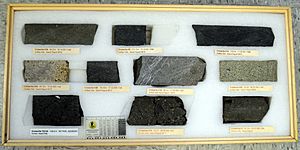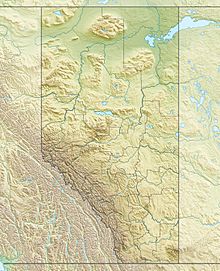Northern Alberta kimberlite province facts for kids
The Northern Alberta Kimberlite Province (NAKP) is a special area in north-central Alberta, Canada. It has groups of ancient volcanic pipes, which are like old volcano vents. Most of these pipes are made of a rock called kimberlite, and some of them even contain diamonds!
These groups of pipes are known as the Birch Mountains (BM), Buffalo Head Hills (BHH), and the Mountain Lake cluster (ML). Scientists found them between 1990 and 1997. Most of these pipes formed during the Late Cretaceous period, about 66 to 93 million years ago. A few are even younger, from the early Paleocene period.
Where is the NAKP located?
The NAKP kimberlite fields are found about 350 to 450 km (217 to 280 mi) north to northwest of Edmonton. This area is between 55° and 57°N latitude and 115° and 118°W longitude.
The region is part of the Canadian boreal forest, which is a huge area of mostly evergreen trees. Not many people live here. The area includes the Buffalo Head Hills and the Birch Mountains, and the Wabasca River and Alberta Highway 88 pass through it.
How did these rocks form?
The NAKP kimberlite fields are lined up in a northeast-southwest direction for about 350 km (217 mi). This line is similar to the direction of big cracks in the Earth's crust, like the Great Slave Lake Shear Zone to the north and the Snowbird Tectonic Zone to the south.
These pipes sit on top of, or near, a very old and strong part of the Earth's crust called the Buffalo Head Terrane. This part of the crust is about 2.0 to 2.4 billion years old and is made of Precambrian rock, but you can't see it on the surface.
Below the surface, the ancient Precambrian rocks are covered by about 500 to 2,200 m (1,600 to 7,200 ft) of younger sedimentary rocks. On top of that, there are loose sediments left behind by glaciers from the Ice Age.
What are these rocks like?

The volcanic rocks found in the BHH and BM areas are known as kimberlites. The rocks from the ML area are a bit different. Scientists have called them various things, like alkaline ultramafic rocks or basanite. It's hard to classify them exactly because they have changed a lot due to clay alteration, which has hidden most of their original minerals.
All the rocks in the NAKP were formed by explosive volcanic eruptions. Most of them are "maar-style diatremes." Imagine a wide, shallow volcanic crater formed by an explosion, with steep sides and a low rim of material thrown out.
These rocks were deposited by two main volcanic processes:
- Pyroclastic fall: When volcanic ash and rock fragments fall out of the sky after an eruption.
- Pyroclastic surge: When a fast-moving cloud of hot gas and volcanic debris sweeps across the ground.
There are also deposits that formed when water moved and redeposited material from these eruptions.
The NAKP volcanic rocks, including those from the ML pipes, contain many small rock fragments called lapilli and a mineral called olivine. These are held together in a fine-grained material. Other minerals you might find include serpentine, clay minerals, carbonate minerals, phlogopite, ilmenite, perovskite, spinel, apatite, pyrite, and, in some special cases, diamonds!


